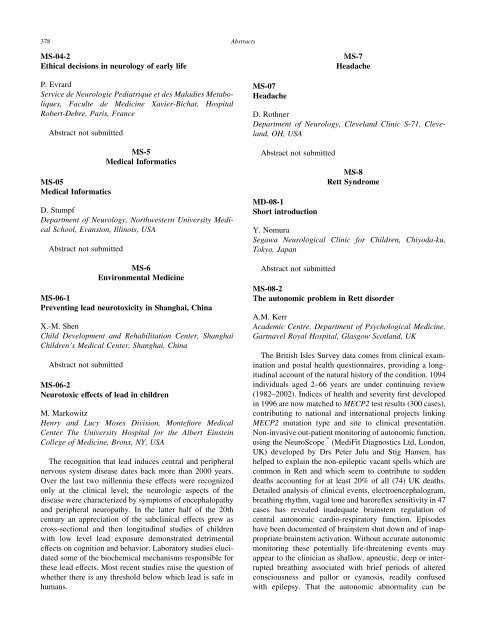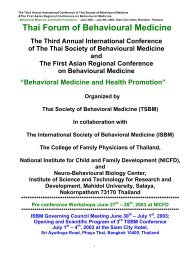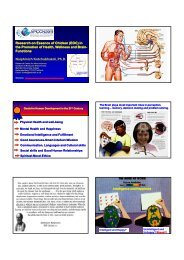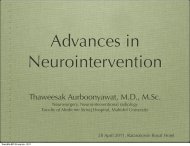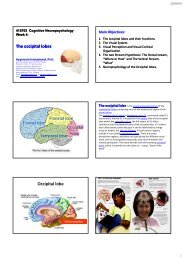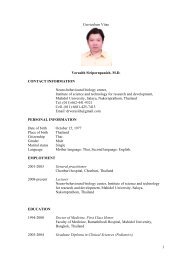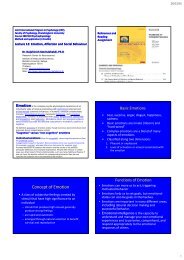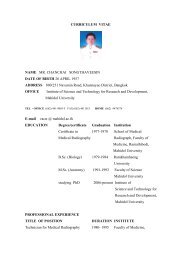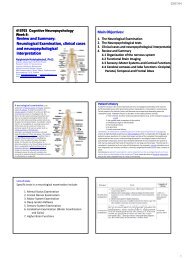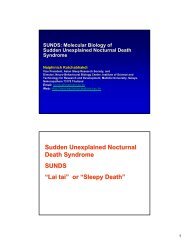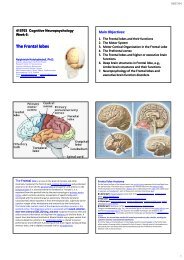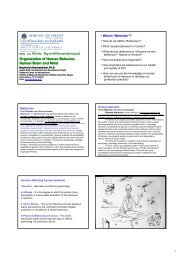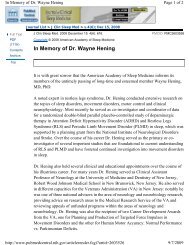PDF File - Mahidol University
PDF File - Mahidol University
PDF File - Mahidol University
You also want an ePaper? Increase the reach of your titles
YUMPU automatically turns print PDFs into web optimized ePapers that Google loves.
378<br />
Abstracts<br />
MS-04-2<br />
Ethical decisions in neurology of early life<br />
P. Evrard<br />
Service de Neurologie Pediatrique et des Maladies Metaboliques,<br />
Faculte de Medicine Xavier-Bichat, Hospital<br />
Robert-Debre, Paris, France<br />
Abstract not submitted<br />
MS-05<br />
Medical Informatics<br />
MS-5<br />
Medical Informatics<br />
D. Stumpf<br />
Department of Neurology, Northwestern <strong>University</strong> Medical<br />
School, Evanston, Illinois, USA<br />
Abstract not submitted<br />
MS-6<br />
Environmental Medicine<br />
MS-06-1<br />
Preventing lead neurotoxicity in Shanghai, China<br />
X.-M. Shen<br />
Child Development and Rehabilitation Center, Shanghai<br />
Children’s Medical Center, Shanghai, China<br />
Abstract not submitted<br />
MS-06-2<br />
Neurotoxic effects of lead in children<br />
M. Markowitz<br />
Henry and Lucy Moses Division, Montefiore Medical<br />
Center The <strong>University</strong> Hospital for the Albert Einstein<br />
College of Medicine, Bronx, NY, USA<br />
The recognition that lead induces central and peripheral<br />
nervous system disease dates back more than 2000 years.<br />
Over the last two millennia these effects were recognized<br />
only at the clinical level; the neurologic aspects of the<br />
disease were characterized by symptoms of encephalopathy<br />
and peripheral neuropathy. In the latter half of the 20th<br />
century an appreciation of the subclinical effects grew as<br />
cross-sectional and then longitudinal studies of children<br />
with low level lead exposure demonstrated detrimental<br />
effects on cognition and behavior. Laboratory studies elucidated<br />
some of the biochemical mechanisms responsible for<br />
these lead effects. Most recent studies raise the question of<br />
whether there is any threshold below which lead is safe in<br />
humans.<br />
MS-07<br />
Headache<br />
MS-7<br />
Headache<br />
D. Rothner<br />
Department of Neurology, Cleveland Clinic S-71, Cleveland,<br />
OH, USA<br />
Abstract not submitted<br />
MD-08-1<br />
Short introduction<br />
MS-8<br />
Rett Syndrome<br />
Y. Nomura<br />
Segawa Neurological Clinic for Children, Chiyoda-ku,<br />
Tokyo, Japan<br />
Abstract not submitted<br />
MS-08-2<br />
The autonomic problem in Rett disorder<br />
A.M. Kerr<br />
Academic Centre, Department of Psychological Medicine,<br />
Gartnavel Royal Hospital, Glasgow Scotland, UK<br />
The British Isles Survey data comes from clinical examination<br />
and postal health questionnaires, providing a longitudinal<br />
account of the natural history of the condition. 1094<br />
individuals aged 2–66 years are under continuing review<br />
(1982–2002). Indices of health and severity first developed<br />
in 1996 are now matched to MECP2 test results (300 cases),<br />
contributing to national and international projects linking<br />
MECP2 mutation type and site to clinical presentation.<br />
Non-invasive out-patient monitoring of autonomic function,<br />
using the NeuroScope e (MediFit Diagnostics Ltd, London,<br />
UK) developed by Drs Peter Julu and Stig Hansen, has<br />
helped to explain the non-epileptic vacant spells which are<br />
common in Rett and which seem to contribute to sudden<br />
deaths accounting for at least 20% of all (74) UK deaths.<br />
Detailed analysis of clinical events, electroencephalogram,<br />
breathing rhythm, vagal tone and baroreflex sensitivity in 47<br />
cases has revealed inadequate brainstem regulation of<br />
central autonomic cardio-respiratory function. Episodes<br />
have been documented of brainstem shut down and of inappropriate<br />
brainstem activation. Without accurate autonomic<br />
monitoring these potentially life-threatening events may<br />
appear to the clinician as shallow, apneustic, deep or interrupted<br />
breathing associated with brief periods of altered<br />
consciousness and pallor or cyanosis, readily confused<br />
with epilepsy. That the autonomic abnormality can be


